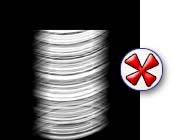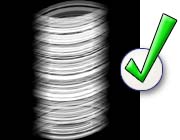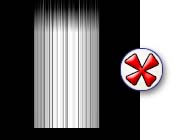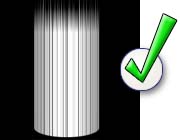![]()
There are a few things you should consider when you make your effect.
1) Never do "cut off" sprites. What I mean is sprites that go outside the screen size so are cut off.

The problem with this is that you can see it is cut off when someone makes a character the has some sort of shake effect on the screen (like with a super move). It is always best to draw the whole sprite.

This also applies to ground effects. Try to add a bit of dimension to your ground effects if possible. For example, just say you have a column of energy. The basic thing would be to make it with a flat base. Easy, no? Well, if you add a little extra arc below, you get a little bit more realistic dimension to your effect.


2) Work in greyscale. It is just easier to work with and you can colour afterwards. Trust me, headaches are abound if you create your effects in colour first. Consider the work if you have to redo certain sprites or just fix certain bits or sprites later. That extra time can be better utilised somewhere else.
Oh, and before you colour your sprites, save a greyscale version first so if you make a mistake or just want to change colours, you can use the greyscale back-up to redo your sprites.
3) Try to work as flat as possible at first. You will find that when you try to work with curves and at certain angles, it will be a real pain in the butt. If you can, try to imagine your effect in the most way possible so that you can work faster and easier.
 |
 |
|
|
Working straight: Easy!
|
Working curved: Hard!
|
Also, you will find that may need to do things at right angles or even upside down. For example, with the wind filter or shear filter you can only work horizontally.
Sometimes you will find that you have to animate flat first before distorting for the final sprites. And, as you have seen earlier, sometimes you have to "reverse engineer" beforehand to give you good reference images.
4) Working with a smaller palette can make things easier for you especially if you are creating your first character. But when you create effects it can sometimes be a problem as you warp and distort your sprites because anti-aliasing makes them blurry and adds extra shades of grey. So, the posterize function in Photoshop (Image > Adjustments > Posterize) is useful in this case. Sadly, you should avoid using colour in your sprites before using this function or you will end up with screwed up colours. It is better to desaturate, posterize and then colour using hue/saturation, gradient map, etc… once you are sure of your sprite.
5) As I have shown you a few times in some of the tutorials, it can be a big bonus to work with layer masks because you can preserve the general shape of your effect sprites, leaving you to colour, streak, add details, etc… freely. Just make sure that you have the right layer element selected first in your layer palette. EG if you are painting the layer, have the layer selected. If you are painting the layer mask then make sure that the layer mask is selected.
6) Even though you might not want to create your effects like mine (IE glowing light FX), you can still use my techniques to give you a set of references that you can trace over.
7) There are programs that can help you create your animated effects much more quickly than manually creating them. In some cases you could use a 3d program or even Flash. You could also try Particle Illusion (www.wondertouch.com), which is a great program for non-loop particle effects. Check out their site for a demo of the software. Even though it is a demo and you can't really save out your animations, you still have a screen capture function (hint, hint).